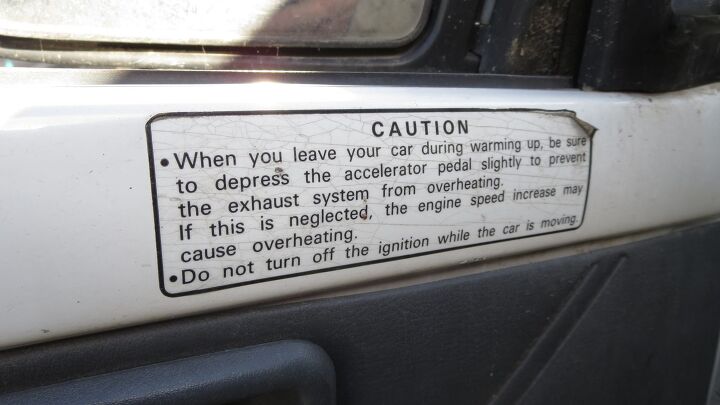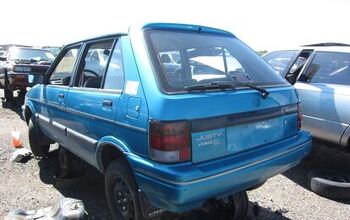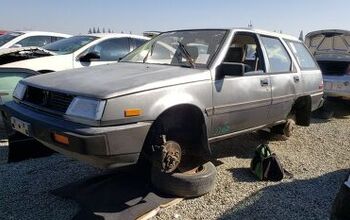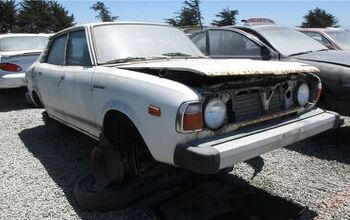Junkyard Find: 1988 Subaru Justy DL

You can’t talk about the miserable econoboxes of the 1980s without talking about perhaps the most miserable of them all: the irresistibly cheap, irredeemably terrible, front-wheel-drive Subaru Justy (the all-wheel-drive Justy could be a lot of fun, of course).
You won’t see many of these cars today, but I was able to find this 28-year-old survivor in a Silicon Valley U-Wrench-It yard.
How many miles on the clock? We’ll never know, because Subaru followed Detroit’s lead and held onto five-digit odometers for these cars, long after nearly all the other Japanese manufacturers went to a full six digits.
Catalytic converters had become fairly sophisticated and trouble-free by this time, at least compared to their predecessors of a decade earlier, but a choke-equipped carburetor coupled with yen-pinching components meant that Justy owners could still recreate the middle 1970s with exhaust-system fires.
What is this, some kind of cruel joke?
Sixty-six horses came out of this 1.2-liter, three-cylinder engine. That’s a lot better than the Chevrolet Sprint‘s 48 horsepower three-banger.
At least this car has the 5-speed manual transmission, rather than the nightmarish CVT that went in many of these cars. Hateful as many 2016 CVTs might be, they’re incredibly sophisticated next to the slippy, random-ratio-selecting, yowling 1980s Subaru version.
This car even had air conditioning!
In Japan, the Justy was depicted as the kind of car a dog would drive around Los Angeles, while making statements learned in first-year English classes. Good morning! How are you? Hey, come on!
In the United States, Subaru pitched the Justy as a cheap-as-hell car that you could abuse — which, as it turned out, was fairly accurate.
[Images: © 2016 Murilee Martin/The Truth About Cars]

Murilee Martin is the pen name of Phil Greden, a writer who has lived in Minnesota, California, Georgia and (now) Colorado. He has toiled at copywriting, technical writing, junkmail writing, fiction writing and now automotive writing. He has owned many terrible vehicles and some good ones. He spends a great deal of time in self-service junkyards. These days, he writes for publications including Autoweek, Autoblog, Hagerty, The Truth About Cars and Capital One.
More by Murilee Martin
Latest Car Reviews
Read moreLatest Product Reviews
Read moreRecent Comments
- Wolfwagen How about some standardization of wiper controls? I have 5 different cars in my family's fleet and have driven a ton of rentals for work. Holy F*cking Sh*t Balls! Left side, right side, push the lever up to turn on, push the lever down to turn on, push the lever forward to turn on, pull the lever back to turn, slide indicator to the left to decrease intermittent wipe time, slide indicator to the right to decrease intermittent wiper time.
- Redapple2 Someone else said it. Looks like a 4/5 size ford edge (front and back)
- Rochester Tim, where was your head at in 1984 when it became a law to wear your seatbelt? Personally I thought it was none of the Gubmint's bizniss to force me to belt up. Today, I feel exposed and unsafe without it. My point is, give it time, both the tech and your values will evolve.
- Theflyersfan After looking it over, Honda, I want royalties for this one: The Honda Yawn.
- V8fairy Not scared, but I would be reluctant to put my trust in it. The technology is just not quite there yet

















































Comments
Join the conversation
I have a 1989 CVT Justy sitting in front of the house right ow, it's my city car. Its fun to drive, I dont mind the cvt below 50 mph. You just have to let the transmission do all the work instead of the engine. Its a simpe transmission, if driven as it should be will last a long long time.
I've owned a couple of these, both 1.2i manual 4WDs (no FWD Justys were available in the UK). They're very lightly built but feel relatively solid, handle well and more than keep up with traffic. I don't know why they get such a bashing whenever they're mentioned on here.